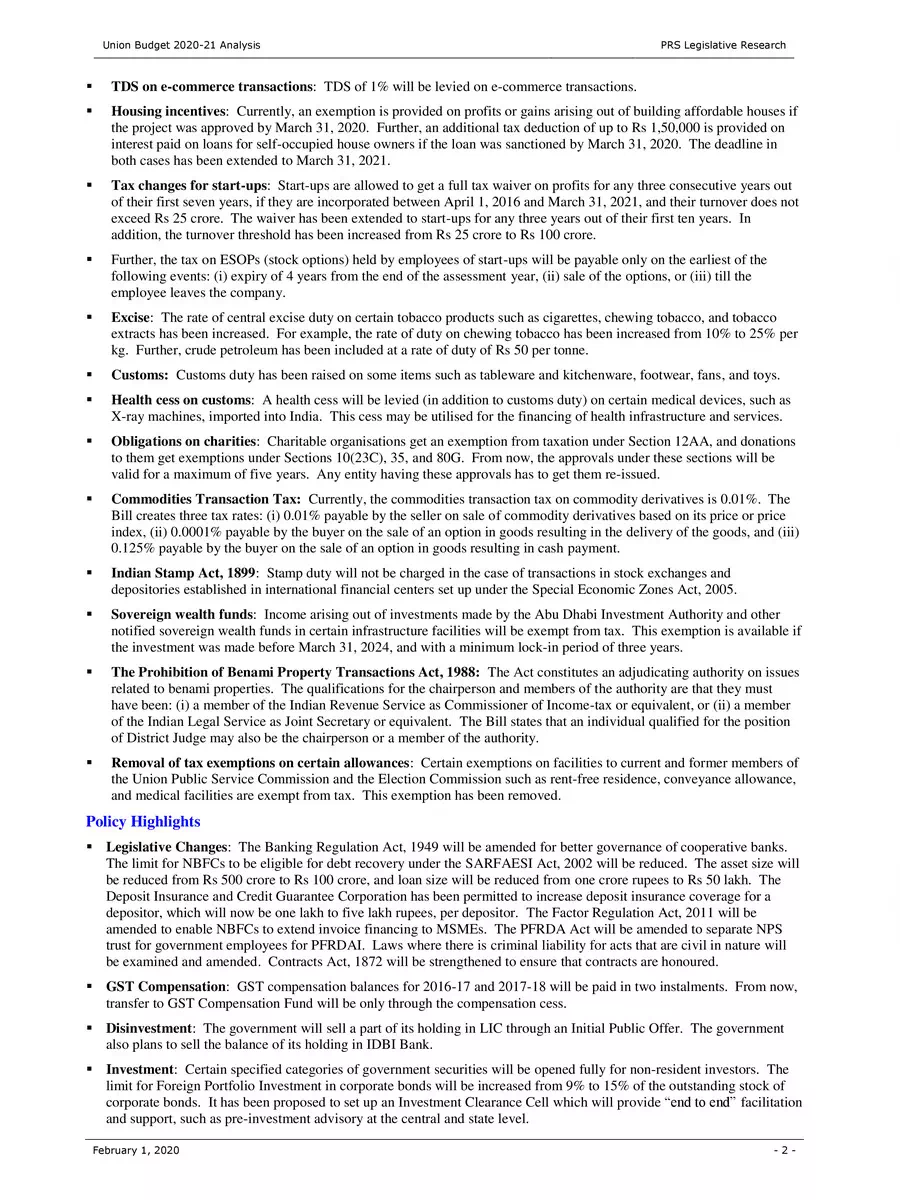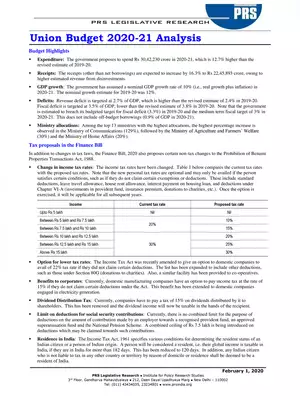Budget 2020-21 Summary
Presenting the first Union Budget of the third decade of the 21st century, Finance Minister Smt. Nirmala Sitharaman, today unveiled a series of far-reaching reforms, aimed at energizing the Indian economy through a combination of short-term, medium-term, and long term measures.
The Union Budget has been structured on the overall theme of “Ease of Living.” This has been achieved by farmer friendly initiatives such as Agriculture credit target of Rs 15 lakh crore for 2020-21; schemes of “Kisan Rail” and “Krishi Udaan” for a seamless national cold supply chain for perishables; and expansion of PM-KUSUM to provide 20 lakh farmers for setting up stand-alone solar pumps.
In the health sector, the Budget proposes more than 20,000 empanelled hospitals under PM Jan Arogya Yojana for poor people; and expansion of Jan Aushadhi Kendra Scheme to all districts offering 2000 medicines and 300 surgicals by 2024.
Infrastructure receives a boost, with 100 more airports by 2024 to support Udaan scheme; and operation of 150 passenger trains to be done through PPP mode.
Starting apprenticeship embedded courses through 150 higher educational institutions by March 2021 and a proposal to establish Indian Institute of Heritage and Conservation are some other major highlights.
The Finance Minister said that the Union Budget Aims:
-
- To achieve seamless delivery of services through Digital governance
- To improve physical quality of life through National Infrastructure Pipeline
- Risk mitigation through Disaster Resilience
- Social security through Pension and Insurance penetration.
- The budget is woven around three prominent themes:
-
- Aspirational India in which all sections of the society seek better standards of living, with access to health, education and better jobs.
- Economic development for all, indicated in the Prime Minister’s exhortation of “SabkaSaath, SabkaVikas, SabkaVishwas”.
- Caring Society that is both humane and compassionate, where Antyodaya is an article of faith.
-
- The three broad themes are held together by
-
- Corruption free – policy-driven good governance
- Clean and sound financial sector.
-
Agriculture, Irrigation and Rural Development
The Finance Minister said that more than Rs 2.83 lakh crore would be spent on Agriculture, Rural Development, Irrigation and allied activities as farmers and rural poor continue to remain the key focus of the Government. Reiterating the commitment of doubling farmers’ income by 2022, She said, Government has already provided resilience for 6.11 crore farmers insured under PM Fasal Bima Yojana. Agriculture credit target for the year 2020-21 has be set at Rs 15 lakh crore. All eligible beneficiaries of PM-KISAN will be covered under the KCC scheme. Moreover, comprehensive measures for one hundred water stressed districts, proposal to expand PM-KUSUM to provide 20 lakh farmers for setting up stand-alone solar pumps and for another 15 lakh farmers to solarise their grid-connected pump sets, setting up of efficient warehouses at the block/taluk level and in Horticulture sector with focus on “one product one district” for better marketing and export are some of the steps in that direction. Foot and Mouth disease, brucellosis in cattle and also peste des petits ruminants(PPR) in sheep and goat to be eliminatated by 2025, Coverage of artificial insemination to be increased from the present 30% to 70%, MNREGS to be dovetailed to develop fodder farms, doubling of milk processing capacity from 53.5 million MT to 108 million MT by 2025 to be facilitated. Similarly on the Blue Economy, raising of fish production to 200 lakh tonnes is proposed by 2022-23. Youth to be involved in fishery extension through 3477 Sagar Mitras and 500 Fish Farmer Producer Organisations. Fishery exports hoped to be raised to Rs 1 lakh crore by 2024-25. DeenDayalAntyodayaYojana- for alleviation of poverty, half a crore households are mobilized with 58 lakh SHGs and it will be further expanded.
Wellness, Water and Sanitation
Dwelling on the Wellness, Water and Sanitation theme, Smt Sitharaman said Rs 69,000 crore is being provided for Health care including Rs 6400 crores for Prime Minister Jan ArogyaYojana (PMJAY). She said, under PM Jan ArogyaYojana (PMJAY), there are more than 20,000 empanelled hospitals more in Tier-2 and Tier-3 cities for poorer people. Setting up hospitals in the PPP mode mainly in Aspirational Districts, using machine learning and AI, in the Ayushman Bharat scheme, “TB Harega Desh Jeetega” campaign to end Tuberculosis by 2025, expansion of Jan Aushadhi Kendra Scheme to all districts offering 2000 medicines and 300 surgicals by 2024 are some of the other wellness measures in the Budget.
Education and Skills
On Education and Skill front, the Finance Minister said Rs 99,300 crore is being allocated in 2020-21 and Rs 3000 crores for skill development. New Education Policy will be announced soon. About 150 higher educational institutions will start apprenticeship embedded degree/diploma courses by March 2021. Degree level full-fledged online education programme to be started. Under its “Study in India” programme, an Ind-SAT is proposed to be held in Asian and African countries. A National Police University and a National Forensic Science University are being proposed in the domain of policing science, forensic science, cyber-forensics etc. It is proposed that special bridge courses be designed by the Ministries of Health, Skill Development.
Industry, Commerce and Investment
Referring to the theme of Economic Development, the Finance Minister said that Rs 27300 crore would be allocated for development and promotion of Industry and Commerce for the year 2020-21. An Investment Clearance Cell will be set up to provide “end to end” facilitation. It is proposed to develop five new smart cities in collaboration with States in PPP mode. A scheme to encourage manufacture of mobile phones, electronic equipment and semi-conductor packaging is also proposed. A National Technical Textiles Mission would be set up with a four-year implementation period from 2020-21 to 2023-24 at an estimated outlay of Rs 1480 crore to position India as a global leader in Technical Textiles. To achieve higher export credit disbursement, a new scheme, NIRVIK is being launched to support mainly small exporters. Government e-Marketplace (GeM) is moving ahead for creating a Unified Procurement System in the country for providing a single platform for procurement of goods, services and works. It is proposed to take the turnover of GeM to Rs 3 lakh crores. 3.24 lakh vendors are already on this platform.
Infrastructure
On Infrastructure sector as highlighted by the Prime Minister that Rs 100 lakh crore would be invested over the next 5 years, National Infrastructure Pipeline was launched on 31st December 2019 of Rs 103 lakh crore. It consists of more than 6500 projects across sectors and are classified as per their size and stage of development. She said that about Rs 22,000 crore has already been provided as support to Infrastructure Pipeline. Accelerated development of highways will be undertaken. This will include development of 2500 Km access control highways, 9000 Km of economic corridors, 2000 Km of coastal and land port roads and 2000 Km of strategic highways. Delhi-Mumbai Expressway and two other packages to be completed by 2023. Chennai-Bengaluru Expressway also be started. It is proposed to monetise at least 12 lots of highway bundles of over 6000 Km before 2024. Indian Railways aims to achieve electrification of 27000 Km of tracks. She said that within 100 days of assumption of this government, it has commissioned 550 wi-fi facilities in as many stations. Four station re-development projects and operation of 150 passenger trains would be done through PPP mode. The process of inviting private participation is underway. More Tejas type trains will connect iconic tourist destinations. High speed train between Mumbai to Ahmedabad would be actively pursued. Similarly, 100 more airports would be developed by 2024 to support Udaan scheme. Air fleet number expected to go up from the present 600 to 1200 during this time. Allocation of Rs 1.70 lakh crore proposed for transport Infrastructure in 2020-21. Similarly, allocation of Rs 22,000 crore proposed for power and renewable energy sector in 2020-21. Expansion of the national gas grid from the present 16,200 km to 27,000 km proposed.
New Economy
On New Economy, Smt Sitharaman said that a policy to enable private sector to build Data Centre parks throughout the country will be brought out soon. Fibre to the Home (FTTH) connections through Bharatnet will link 100,000 gram panchayats this year. It is proposed to provide Rs 6000 crore to Bharatnet programme in 2020-21. Measures proposed to benefit the Start-ups include a digital platform for seamless application and capture of IPRs, Knowledge Translation Clusters to be set up across different technology sectors including new and emerging areas. For designing, fabrication and validation of proof of concept, and further scaling up Technology Clusters, harbouring test beds and small scale manufacturing facilities to be established. It is proposed to provide an outlay of Rs 8000 crore over a period five years for the National Mission on Quantum Technologies and Applications.
Women and Child, Social Welfare
Harping on the theme of Caring Society, the Finance Minister said that Rs 35,600 crore proposed for nutrition-related programmes for the financial year 2020-21. Rs 28,600 crore proposed for programs that are specific to women. Moreover, Rs 85000 crore would be allocated towards the welfare of Scheduled Castes and Other Backward classes for 2020-21. Similarly, for furthering development and welfare of Scheduled tribes, Rs 53,700 crore is proposed for 2020-21. She said, the government is mindful of the concerns of senior citizens and Divyang. Accordingly, an enhanced allocation of Rs 9,500 crore is being provided for 2020-21.
Culture and Tourism
On Culture and Tourism, establishment of an Indian Institute of Heritage and Conservation under Ministry of Culture proposed with the status of a deemed University. 5 archaeological sites to be developed as iconic sites with on-site Museums – Rakhigarhi (Haryana), Hastinapur (Uttar Pradesh) Shivsagar (Assam), Dholavira (Gujarat) and Adichanallur (Tamil Nadu). Re-curation of the Indian Museum in Kolkata, announced by Prime Minister in January 2020. Museum on Numismatics and Trade to be located in the historic Old Mint building Kolkata. 4 more museums from across the country to be taken up for renovation and re-curation. Support for setting up of a Tribal Museum in Ranchi (Jharkhand). Maritime museum to be set up at Lothal- the Harrapan age maritime site near Ahmedabad, by Ministry of Shipping.
Environment and Climate Change
On Environment, States that are formulating and implementing plans for ensuring cleaner air in cities above one million to be encouraged. Parameters for the incentives to be notified by the Ministry of Environment, Forests and Climate change and the allocation for this purpose is Rs 4,400 crore for 2020-21.
Governance
Dwelling on the issue of Governance as clean, corruption-free, policy driven and good in intent and most importantly trusting in faith, the Finance Minister announced setting up of a National Recruitment Agency (NRA) as an independent, professional, specialist organisation for conduct of a computer-based online Common Eligibility Test for recruitment to Non-Gazetted posts. A test-centre in every district, particularly in the Aspirational Districts would also be set up. It is also proposed to evolve a robust mechanism for appointment including direct recruitment to various Tribunals and specialised bodies to attract best talents and professional experts. Deliberation to strengthen the Contract Act is also on.
You can download the Budget 2020-21 Summary in PDF format using the link given below.



SUMMARY IF INDIAN BUDGET